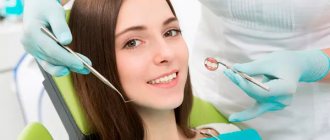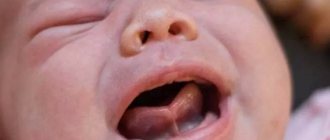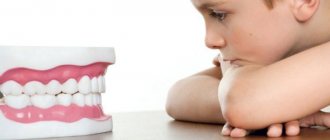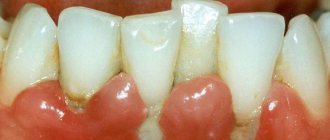October 21, 2018
Everyone who regularly visits a dental office has an idea of what oral sanitation is. This is a set of measures whose main goal is to prevent the development of any dental diseases. Oral sanitation also allows you to improve the health of your teeth and gums, restore their functionality and beautiful appearance if necessary. The procedures will help get rid of pathogenic microflora, all kinds of foci of infection that can affect not only the teeth, but also penetrate inside the body.
What procedures are included in the complex of oral cavity sanitation?
The editors of the UltraSmile.ru portal suggest not to ignore this topic, but to understand in as much detail as possible all the nuances of oral sanitation. This will be very useful for enriching your horizons and will help you understand exactly when a useful event may come in handy.
What is oral sanitation and what procedures does it consist of?
Sanitation of the oral cavity is a set of measures aimed at treating diseases of this area (teeth, gums, tongue, mucous membranes) or preventing their occurrence, as well as eliminating various pathologies (congenital or acquired).
The complex of these measures includes the following procedures:
- treatment of caries (including complicated ones that have progressed to pulpitis or periodontitis). This is the most frequent therapeutic intervention, since almost 90% of the population suffers from dental caries, and also because it is with minor destruction of the enamel that large and intractable problems begin - diseases of the dental roots, infectious lesions of hard and soft tissues, destructive lesions leading to loss of functional units,
- treatment of periodontitis. This is a disease that affects various structures around the tooth root. The danger is that during inflammation, the infection can spread not only to neighboring teeth, but also to the bone, and even to other organs of the head - eyes, ears, sinuses,
- treatment of tooth enamel destruction (including hypoplasia). The enamel covering the crown performs a protective function, so any violation of its integrity threatens damage to softer and unprotected tissues. Depending on the diagnosis and the degree of development of the pathology, the doctor builds a treatment strategy - from the use of remineralizing pastes to installing crowns on the affected teeth.
- treatment of inflammatory processes of soft tissues of the oral cavity. These can be diseases of the gums, tongue, oral mucosa, palate and larynx. Therapy tactics are built depending on the diagnosis and individual factors of the patient’s condition (heredity, pregnancy, the presence of other diseases that provoke inflammation in the oral cavity, bad habits, etc.),
- elimination of tooth deformation (both congenital and acquired) and filling defects. Depending on the clinical picture, defects are corrected using fillings or prosthetics,
- cleaning and curettage of gum pockets. Gum pockets are called the separation of the edge of the gum from the wall of the tooth. In such depressions, as a rule, plaque accumulates, which then hardens, turning into tartar. All sorts of pathogenic microbes love to live there. Removing these deposits prevents the spread of infection and the development of many diseases,
- removal of teeth that have completely lost their functionality. The doctor resorts to this method when restoring the unit is no longer possible for some reason,
- correction of bite. This stage is very important for maintaining dental health, since malocclusion causes inconvenience not only in aesthetic terms. With various defects in the dentition, digestion and speech are affected, the process of salivation is disrupted, and there is a risk of developing caries or other infectious diseases,
- prosthetics. Replacing missing teeth is needed not only to restore the aesthetics of a smile. A complete set of teeth allows you to chew food better, improve diction, maintain the strength of the jaw bone,
- professional teeth cleaning. This set of preventive procedures includes not only the removal of plaque and tartar, but also the treatment of crowns with special restorative and protective preparations, bleaching, fluoridation, silvering (mainly for children) and other hygienic procedures.
Restoring the shape and aesthetics of teeth
Sanitation in dentistry is a set of measures that are primarily aimed at preventing various dental diseases or getting rid of existing problems with teeth and gums. If, during the development of the disease, the beauty and functionality of the patient’s dentition has suffered, then the specialist will help him solve this issue.
Translated from Latin, sanatio means “treatment” or “healing.” For the entire range of sanitation measures, it is often necessary to involve not only the dentist. But it may also require coordinated work of a surgeon, orthopedist, orthodontist, periodontist...
Veneers can help correct dental defects
Depending on the clinical picture, the doctor can install veneers or lumineers, restore with composite or filling material, fix inlays, single crowns or bridges, carry out implantation and subsequent fixed prosthetics, and perform removable prosthetics.
Indications for sanitation
- upcoming surgical treatment (even with minor interventions, such as abortion, replacement of the eye lens, removal of adenoids, etc.). This is done in order to avoid complications after surgery, because an infection from the oral cavity can enter the blood,
- entering kindergarten or school. Upon admission to an educational institution, a health card is created for each student, which indicates chronic and other diseases, and also monitors what treatment the child receives,
- before pregnancy. When planning to become a mother, women should take care of their health, since pregnancy is a serious test for the body, and the presence of infectious diseases can become a serious test for the fetus. Therefore, it is important to take preventive measures in advance,
- upcoming orthopedic (prosthetics, implantation) or orthodontic (bite correction) treatment,
- work in hazardous industries (especially those related to the chemical industry). Harsh working conditions weaken the body, so workers in hazardous professions must undergo a medical examination, and if any pathologies are detected, immediately receive medical care.
- a history of serious illness (such as diabetes, tuberculosis, rheumatological systemic diseases, etc.). Such complex diagnoses, as a rule, disrupt the functionality of many body systems, and teeth are most often the first to be affected.
- the presence of chronic or genetically determined oral diseases,
- passing the draft commission (for conscript or contract service),
- upcoming long-term business trip to places with limited medical care (for example, third world countries), expeditions, extreme hikes.
Safe anesthesia options for pregnant women
Dental treatment under anesthesia during pregnancy is clearly prohibited - only local painkillers can be used. However, local anesthesia for dental treatment during pregnancy is very important: severe pain during treatment can cause a surge of adrenaline, which can dangerously affect the unborn baby and even cause premature birth.
Novocaine and lidocaine should be excluded from local anesthetics - they can cause muscle weakness, cramps, pressure changes, dizziness and vomiting. Ubistezin, ultracaine, artifrin, alfacaine are considered safer painkillers for dental treatment during pregnancy, because they do not have a vasoconstrictor effect and almost do not penetrate the placenta.
How is sanitation carried out?
This event is usually divided into three types:
- individual (is the initiative of the patient himself),
- periodic (if the patient falls into one of the groups for which undergoing sanitation is a necessity, for example, before surgery or pregnancy),
- planned (when the procedure is included in the occupational safety plan or is a prerequisite for employment).
Stages of reorganization
Stage 1: diagnostic.
At this stage, the dentist examines the oral cavity and identifies defects that need to be eliminated. In some situations, the doctor may prescribe an additional examination - tests, x-rays or ultrasound diagnostics to identify hidden problems.
Stage 2: therapeutic.
This stage is always individual. Its duration, intensity and cost depend on the identified pathologies and the choice of method for their elimination. If the condition of the oral cavity is neglected, then sanitization begins with the removal of damaged teeth, “stumps” and restoration of the gums. Next, the doctor follows the individual clinical picture,
Stage 3: preventive.
For the purpose of prevention, the doctor necessarily recommends that the patient undergo professional teeth cleaning, during which all deposits are removed, and then he applies strengthening or protective preparations to the enamel, and carries out whitening if necessary. Sometimes this stage precedes treatment and even diagnosis. This is done to make it easier to identify problems, because carious lesions and other foci of infection may be hidden under a layer of plaque. And professional hygiene reduces the risk of re-infection with caries during treatment.
Remember! You can skip the therapeutic stage if you pay due attention to oral hygiene every day, follow your doctor’s recommendations and give up bad habits. Preventing caries allows you to avoid more serious health problems and save money.
Comments
I heard that it is useless to sanitation the oral cavity if there are internal diseases of the body. Is it really?
Veronica H. (10/22/2018 at 05:50 pm) Reply to comment
- Dear Veronica! Indeed, all diseases need to be treated comprehensively. For example, scientists have proven that pathologies of the gastrointestinal tract can have the greatest impact on the condition of the oral cavity, because It is from there that pathogenic microorganisms best penetrate the oral cavity and begin to circulate there. If gastrointestinal diseases are not treated, a vicious circle will form. But this does not mean the opposite: if you have stomach problems, this does not mean that you need to avoid measures to sanitize the oral cavity. This way, you risk losing all your teeth many times faster and increasing the number of health problems.
Editorial staff of the portal UltraSmile.ru (10.23.2018 at 12:35) Reply to comment
When applying for a new job at the plant, I was forced to provide a certificate stating that my oral cavity had been sanitized. Although I have to work as a cashier. How legal are such demands?
Lyudmila Konstantinovna (10/23/2018 at 11:50) Reply to comment
- Dear Lyudmila Konstantinovna! Each specific organization sets the rules for hiring. Often at manufacturing enterprises, the conditions for admission and further employment are the same for everyone: both for administrative personnel and for people who work at production sites. A certificate is an officially confirmed document. Moreover, most likely, every year you will now need to confirm data for your personal file about the state of your health, i.e. undergo oral sanitation and other body examinations on an ongoing basis. You can only find advantages for yourself in this, because the company allocates time for you for what employees of many other organizations have to find hours other than work.
Editorial staff of the portal UltraSmile.ru (10.24.2018 at 16:55) Reply to comment
Write your comment Cancel reply
Sanitation during pregnancy
Pregnancy is a very important period not only for the woman herself, but also for her fetus, so it is better to prepare for such an event in advance. Sanitation of the mouth at the stage of pregnancy planning is a must, because during gestation all calcium and other active substances will be sent to the development and growth of the small organism. Therefore, mom needs to take care of the health of her teeth in advance.
Sanitation of the oral cavity allows not only to treat caries, but also to strengthen tooth enamel, because it bears the main burden. The acid-base balance of saliva changes, the body as a whole undergoes hormonal and metabolic changes, and with vomit during toxicosis, gastric juice gets onto the enamel, which corrodes the enamel. That is why it is important to strengthen your teeth and get rid of all pathologies that increase the risk of developing serious diseases, such as pulpitis or periodontitis.
Important! If conception occurred unplanned, then the woman also needs to undergo sanitation, but here it is important to consult a doctor. Firstly, because in the first trimester there are restrictions on the use of various medications (and some of the drugs used in dental treatment still enter the body with saliva). Secondly, in many women, toxicosis and the gag reflex intensify, which makes it impossible to carry out manipulations in the mouth.
Any dentist, seeing a patient who, say, at 30 years old, does not have a single caries, not a single filling and not a single extracted tooth, will say - “He has natural sanitation”...
“A loose mouth is the greatest social evil.”
P.G. Dauge
However, any dentist, when he sees a patient who, say, at the age of 30, does not have a single caries, not a single filling and not a single extracted tooth, will say - “He has natural sanitation”...
“Before leaving Flensburg, where Himmler found his temporary refuge, the doctor performed a small operation: under local anesthesia, he sewed a capsule of potassium cyanide into Heiney’s cheek, from the inside, under the mucous membrane. Unlike others who wanted to keep this little life-saving thing in their mouth just in case, Gainey did not have a single artificial or even filled tooth. He had an amazing mouth. All thirty-two teeth, healthy, strong, white. It's a shame to spoil it. A rare case of natural remediation."
Polina Dashkova "Prize"
Now I will try to argue what we, dentists, mean by this concept, and what is the scientific basis for this...
Differences between individuals are due, on the one hand, to what they inherit from their parents, and on the other, to the influence of the environment. Thus, an adult with “natural rehabilitation” is a product of a complex interaction of two factors - heredity and environment.
The environment refers to any impact on the fetus from the moment of conception, and then on the person from the outside. The very first influences of the environment on the human body appear in the prenatal period: the nutrition of the fetus depends on the substances that come with the maternal blood. As a result of insufficient or improper nutrition of the expectant mother, the child also suffers to a certain extent, who may have delayed maturation of bones and dental tissues. Even the mental state of the expectant mother can affect the fetus.
The condition of a person's teeth is greatly influenced by nutrition. However, often with the same diet, one child develops resistant (resistant) teeth to caries, while another develops caries-resistant teeth. In this regard, many researchers have found that the genetic code also plays a certain role in the proper formation of hard dental tissues. Back in 1971, it was determined that the uniqueness of the dental complex, characteristic of various nations, is explained by the origin of the nationality and genetic processes. The hypothesis of morphogenetic fields also has a right to exist, according to which the structure of teeth is determined by gene control, extending partly to the entire dental system as a whole, partly to individual classes of teeth. It is therefore assumed that there are a number of fields or “spheres of influence of genes”, with some fields having a wider scope and determining general characteristics, while others have more limited spheres of action, determining the development of a trait within one class of teeth. General and class-specific fields interact with each other in complex ways. Adjacent class-specific fields can also “overlap” one another, giving the morphological effect of making teeth of one class similar to teeth of a neighboring class.
Researchers also found that highly qualified athletes have lower rates of dental caries than other individuals. Therefore, physical inactivity (a sedentary lifestyle) can be considered a factor that reduces the resistance of the dental-jaw system to pathology. The mechanism for reducing resistance is explained by “the morphological immaturity of the masticatory apparatus systems and their infantility, which develops due to the discrepancy between the stabilized genetic development program and the actual pace of development dictated by acceleration. This circumstance determines the high vulnerability of the dentofacial system in relation to pathogenic influences that provoke the diseases in question. This connection between premature teething, immaturity of their tissues and caries is especially obvious” (V.R. Okushko).
The teeth of modern humans are subject to gradual changes. The creation of perfect tools of labor influenced human organs, as it reduced physical effort and changed the very content of labor. In particular, the exercise of the masticatory muscles decreased due to the fact that the need for tearing, biting and intensive chewing of raw food products was partially eliminated. This led to changes in the teeth, which were fixed in the offspring, then progressed even more and were fixed again. The teeth of modern humans have thus gone through numerous stages of evolution.
As the function of the teeth changed, the shape, size, structure and function of the jaws changed. The teeth of modern humans are characterized by a loss of massiveness, strength and weight, weak strengthening in the alveolar processes of the jaws and, finally, a tendency towards the disappearance of wisdom teeth, which have essentially turned into vestigial (unnecessary) organs.
Geographical and social (economic) factors are important for the proper formation and maturation of hard dental tissues. Along with changes in the shape and size of a person’s teeth, the structure and composition of their tissues change. The main factor influencing this process, which interests us from the point of view of preventing dental caries, is the tendency for teeth to mature slowly, which leads to the development of caries. As you know, many common diseases begin in the oral cavity or its condition contributes to their development. Infection from diseased teeth spreads to many organs; it can also contribute to allergization of the body and is a source of chronic odontogenic infection, while one must take into account the extremely branched network of vessels extending from the maxillofacial area (including to the brain).
The bad odor of a person’s exhaled air most often depends on the condition of the oral cavity. As you know, odors are important for human life. They have a certain effect on the functions of the human body. Pleasant odors increase the secretion of saliva and the activity of the gastric glands, and stimulate appetite. Unpleasant odors cause various negative reactions, leading to nausea, vomiting, fainting and even illness.
Also, dentists have noticed that dental diseases develop most often in cases where sufficient hygienic care for the oral cavity is not carried out. Such people have relatively large amounts of diverse microflora in their mouths; microorganisms are constantly ingested, which in turn negatively affects the condition of the gastrointestinal tract and can lead to its diseases.
In the oral cavity there are quite favorable conditions for the development and reproduction of microflora: abundance of moisture (saliva), lack of light, pH close to neutral, food residues in the form of carbohydrate and protein breakdown products, constant optimal temperature. In caries-susceptible individuals, lactic acid flora and streptococci multiply abundantly, which contributes to the development of dental caries. The proliferation of these bacteria with insufficient hygienic care of the oral cavity leads to the decomposition (fermentation) of food and the formation of acids - lactic, acetic, pyruvic, etc. Under these conditions, with every sip of food or saliva, a person swallows a huge number of microorganisms that can find favorable soil for reproduction in various parts of the gastrointestinal tract. The more microbes in the mouth, the more they enter the gastrointestinal tract.
If in a healthy stomach many microorganisms die, then with its diseases, accompanied by a decrease in acidity, many microorganisms multiply and then enter the intestines, where they always find favorable soil for even more intensive reproduction. It is known that some intestinal diseases are aggravated due to the entry of microorganisms from the oral cavity. Chronic intoxication of the body aggravates the development of pathology in the digestive tract, and this, in turn, adversely affects the condition of the oral cavity - a vicious circle results. All other things being equal, people with poorly maintained oral cavity are more susceptible to various common diseases.
Oral microorganisms, in addition, can be aspirated (inhaled), which leads to the development of diseases of the bronchi and lungs. If the oral cavity is in poor hygienic condition, it contains a lot of viscous mucus, which significantly complicates the processes of self-cleaning of the teeth and mucous membranes.
Due to the communication between the oral cavity and the inner ear through the auditory tube, the penetration of microorganisms or their metabolic products can also lead to diseases of the hearing organ.
Oral microorganisms under any unfavorable conditions (changes in nutrition, salivary pH, temperature, etc.) can cause pathology, such as dental caries. It has been established that some microorganisms begin to produce acid in larger quantities than in the natural physiological conditions of the oral cavity.
Thus, the need for oral care is obvious. Food particles that remain in the natural cavities of teeth and interdental spaces are quickly fermented with the help of microorganisms. The resulting acids can dissolve the mineral component of the enamel, especially in those places where food debris comes into contact with the surface of the tooth and where it lingers longer. With the simultaneous impact of internal factors on the tooth, destruction of its tissues (caries) can occur. A large amount of soft plaque is deposited in individuals with improperly positioned teeth in the arch. As a rule, upon examination they are found to have multiple caries.
Studies of white plaque (the most common type) have shown that it consists of epithelium exfoliated from the oral mucosa, food debris and various microorganisms. At the same time, the microflora of dental plaque consists of 36% gram-positive cocci, 11% gram-negative, 34% gram-positive rod-shaped microbes, 17% gram-negative rods, including fusobacteria, and 2% spirochetes. In the absence of oral care, 1 mg of dental plaque contains up to 800 million microorganisms, while with regular brushing of teeth - no more than 10 million.
Plaque is soft, stretchy, and easily removed. It forms almost exclusively on the labial and cheek surfaces of the necks of the teeth, as well as between the teeth, near the gums. There is no plaque on the lingual surface of the teeth, as it is erased by the tongue. The presence of abundant plaque indicates insufficient dental care; Plaque is most often found on the side of the jaw that is not involved in the act of chewing, as well as on non-functioning, single-standing teeth. With insufficient oral care and dysfunction of chewing activity, dental plaque can lead to the development of chronic inflammation of the gums with the subsequent formation of periodontal pockets. When salts and mineral elements are added to soft plaque, it mineralizes and turns into tartar, which is usually yellow or dark brown in color.
So, proper oral care is the key to the health of the whole body.
The importance of nutrition in the prevention of dental caries is extremely high. It should be built depending on age and environmental conditions. The main result of the development of science about the absorption of food by the body is the theory of balanced nutrition. It establishes the optimal proportions of various nutrients necessary to maintain human health and performance: proteins (and their constituent amino acids), fats, carbohydrates, minerals, vitamins.
“A person needs a certain amount of nutrients equal to his energy expenditure. According to the theory of balanced nutrition, an adult per day should consume on average 2 liters of water, 80-100 g of proteins, 400-500 g of carbohydrates, 80-100 g of fat (of which 10% comes from vegetable oils), up to 0.1 g vitamins, up to 20 g of salts (including about 10 g of table salt).”
I. Popov and V. Sviridov.
Proper nutrition from the first days of life, along with compliance with other hygienic requirements, is the most important condition for the normal development of a child and increasing the body’s resistance to diseases.
“There is still impenetrable darkness on this issue among most doctors. Studying in great detail the chemical composition of food, its calorie content and the processes that occur in the stomach and intestines, they with criminal neglect ignore the extremely serious preparatory process that occurs with food in the oral cavity. This calls for the energetic intervention of a dentist.”
P.G. Dauge
It has been observed that caries develops more often in people whose diet is rich in refined sugar and high-ground flour, in contrast to those who consume unprocessed plant and animal products containing little free sugar and a significant amount of fiber and raw materials. Caries is currently an important problem in technologically advanced countries. Its prevalence among children and adults continues to increase in all parts of the world, mainly due to changes in diets associated with urbanization and the cultural changes it brings.
Conclusion : “Natural sanitation” is the health of the dentofacial system and the body as a whole, through hereditary predisposition, good oral hygiene, a balanced diet and an adequately active lifestyle.
Sanitation before implantation
Installation of a dental implant is a complex surgical procedure involving the implantation of a foreign body into the jawbone. If there is some source of infection in the oral cavity (an area of carious lesions, inflammation in soft tissues, ulcers on the mucous membranes or tartar), then with a high probability this infection will penetrate into the open wound. This can lead not only to implant rejection, but also to more serious consequences - inflammation of bone tissue and even sepsis.
Therefore, before proceeding directly to installing the implant, the orthopedist directs the patient to sanitize the oral cavity in order to minimize risks.
Indications
Indications for sanitation of the upper respiratory tract are the following symptoms:
- elevated temperature;
- difficulty breathing;
- decreased sense of smell;
- hearing loss and pain in the ears;
- sore, burning and sore throat.
If there are purulent plugs in the tonsils, the tonsils are washed. Indications for sanitation of the nasal cavity are accumulations of secretory or postoperative masses in the nose when it is impossible to remove them independently.
Sanitation in pediatric dentistry
“Putting things in order” in a child’s mouth is an important detail not only in the prevention of caries. Timely sanitation allows you to quickly identify pathologies in the formation of the jaw or bite, correct them and thereby provide the child with healthy and properly functioning teeth.
As a rule, oral cavity sanitation is carried out in kindergartens and schools. Its technology is no different from that of an adult: after an examination, the doctor identifies problem areas, treats caries and carries out professional teeth cleaning. If a child has teeth that cannot be restored, they are removed.
Interesting! According to a sociological study in schools in Moscow and the Moscow region, almost half of parents of children of primary and secondary school age (48%) take their child to the dentist only when a problem arises, and 4.6% do not take their child to the doctor even if a pathology is detected. A fifth of respondents (21%) believe that it is enough to bring the child for examination once a year. And only 24% of respondents bring their children for preventive care twice a year.
Recommendations for the patient for further oral care
Upon completion of therapeutic and health-improving measures, the doctor will definitely tell you how to properly care for your teeth and gums, and recommend the right type of toothbrush and prophylactic paste. If necessary, will teach proper hygiene techniques.
Only following all the rules for cleaning the oral cavity will have its effect.
Your main task is to follow all instructions at home and show up for your dentist appointment on time. If you do this several times a year, then you won’t have to go through the whole range of procedures for sanitation of the oral cavity. Everything will be limited to the first two points described in our article.
Notice
: Undefined variable: post_id in
/home/c/ch75405/public_html/wp-content/themes/UltraSmile/single-item.php
on line
45 Notice
: Undefined variable: full in
/home/c/ch75405/public_html/wp-content /themes/UltraSmile/single-item.php
on line
46
Rate this article:
( 3 ratings, average: 5.00 out of 5)
prevention
- Sabanov V.I., Romanchuk E.V. Epidemiological indicators of caries among first-graders and the dental awareness of their parents. Pediatrician, 2011.











